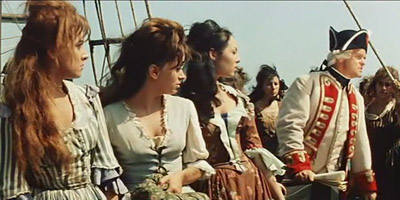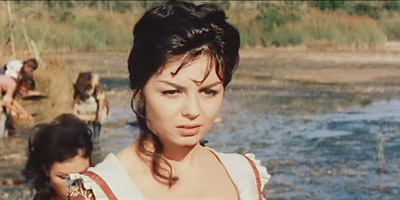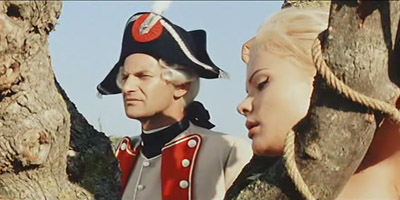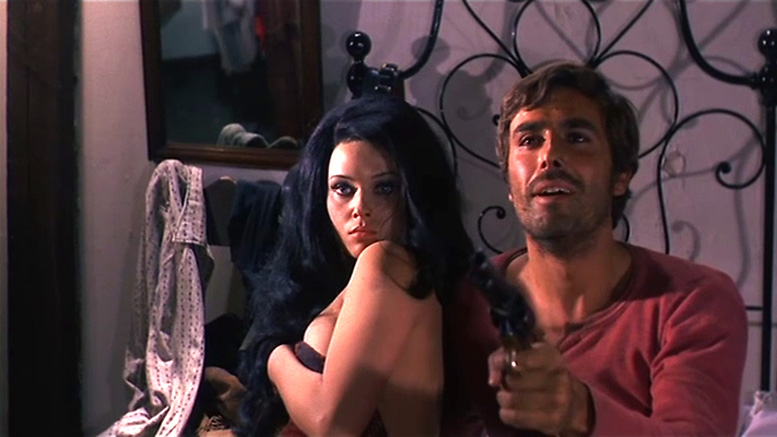
aka Le prigioniere dell’isola del diavolo, L’ile des fillles perdues
1962
Original running time: 90 mins
Italy
Based on the inquiry “Gli orrori della Gujana (France, 1848)
A Gianni Hecht Lucari production for Documento (Italy) and Le Louvre (France)
Distribution by Columbia CEIAD
Director: Domenico Paolella
Screenplay: Domenico Paolella
Cinematography: Carlo Bellero
Music: Egisto Macchi
Editor: Otello Colangeli
Art director: Aldo Tomassini Barbarossa
Cast: Guy Madison (Captain Henri Valliere), Michèle Mercier (Martine Foucher), Frederika [Federica] Ranchi (Jeanette), Marisa Belli (Melina), Paul Muller (Lefèvre), Tullio Altamura (Dubois), Antonella Della Porta (Louise), Carlo Hintermann (Captain Duval), Gisella Arden (Maeva), Fernando Piazza (Micheal, the mulatto), Roldano Lupi (Francis Bart, a pirate), Margaret Rose Kiel (Rosy), Claudine Damon (Pauline), Vera Besusso (Francoise)
Women of Devil’s Island is a 1962 film written and directed by Domenico Paolella, a former critic who specialized in low-but-not-no budget historical adventures and peplums. Paolella obviously was a respected filmmaker at the time, as this was produced by Gianni Hecht’s Documento Film. As well as some respectable genre items (such as Pietro Francisci’s The Warrior Empress (Saffo, venere di Lesbo, 60), Documento was also financing a number of more prestigious and challenging projects at the time, including Vancini’s La banda casaroli (62), Rossellini’s Anima Nera and Lattuada’s L’imprevisto (61). They tended, in other words, to back either directors of some repute or promising newcomers.
Still, they weren’t going to let Paolella relax, and Women of Devil’s Island was shot back-to-back with another film, Avenger of the Seven Seas (Il giustiziere dei mari), which also featured many of the same cast and crew. Of course, this had several budgetary implications, not least the fact that the two vessels hired by the production could be cheaply reused and the exterior shoot for both films, which took place at Ancona, a port on the Eastern side of Italy, could all be done at once.

The plot, by Paolella and Ernesto Gastaldi, follows Martine Foucher (Michèle Mercier), a noblewoman who, convicted of treason for political reasons, is sentenced to life imprisonment on Devil’s Island, a notorious penal colony for women near French Guyana. Her only cause for optimism is the fact that her sister, Jeanette (Federica Ranchi) is already there, having been convicted on a similarly trumped up charge two years previously. However, when they are reunited, Jeanette claims not to recognise her, and Martine’s spirits plunge even further when she’s put to hard labour panning for gold.
The degradations of the camp prove to be relentless: the guards are psychopaths who take advantage of their position to force sexual favours out of their charges, the women are violently punished for even the most minor infringements and, to cap it all, crocodiles wait in the rivers, ready to pick them off at any opportunity. Eventually Jeanette admits who she really is – she’d assumed the identity of another prisoner with a shorter sentence – but is then promptly killed during a misguided escape attempt.
But then a new Commandant, Captain Henri Valliere (Guy Madison), arrives to take charge, and everything changes. An apparently honourable man, he immediately puts a stop to all the corruption and brutality, even risking his own life to save Martine when she’s harassed by one of those pesky crocodiles. But Valliere isn’t exactly who he claims to be: he’s actually one of a band of pirates who are planning to attack the island and seize all the gold, without much of a care for the poor prisoners who are stuck there.
Essentially, this is an enjoyable romp that foresees the later Women in Prison (W.I.P.) movies which came into vogue in the mid 70s. The female prisoners storyline wasn’t a new one – for instance Raffaello Matarazzo had made La nave delle donne maledette, which was primarily set on a ship carrying a similar bunch of women convicts to a similar prison island – back in 1954. It’s not hard to see the appeal: there’s a bit of action, a bit of romance, a lot of melodrama and, most importantly of all, a whole bunch of beautiful women in not a great deal of clothes. As with the later W.I.P. films the guards are almost uniformly horrible, there’s more than a suggestion of sexual exploitation and there’s an ambiguous hero figure who infiltrates (or is part of) the prison. What there isn’t, though, is the relentless sadism and sleaziness – this was made before the time of acceptable nudity and screen violence – and it’s actually all the more enjoyable for it.

Paolella was a dependable hand at this kind of thing, and he does a good job here, ensuring that just about all the budget is firmly visible on screen. With decent cinematography, an enjoyably bombastic soundtrack and colourful costumes and art direction, it stands as a great example of the workshop style of filmmaking which was standard for much of the low-budget Italian cinema being made at the time. Paolella also always tried to pack a little bit of intelligence into his films along with all the cleavages, and this exhibits a typically left-leaning view of the society of the time (the French revolution is mentioned in passing and is seen as a resoundingly good thing). Knowing Paolella, it’s also probably not too far fetched to suggest that he was also trying to make a comment about the then-contemporary penal system in Italy; that you can’t just lock away and brutalise prisoners, you have to rehabilitate them. On a purely narrative level, though, the script also packs in a few surprises and, what’s more, it’s a bit different to the majority of historical adventure movies being made at the time.
As well as having some decently drawn characters, the cast is much better than usual for this kind of thing. Guy Madison, of course, was a regular genre star, but he’s perfectly suited for this kind of role, in terms of talent, physicality and attitude. Michele Mercier, who’d go on to become famous after starring in the popular Angélique series of films in the mid-sixties, is very appealing as the plucky Martine. There are other key roles for the likes of Paul Muller (vicious prison commander), Tullio Altamura (nasty guard), Marisa Belli (of Gelosia, who plays a reluctantly traitorous prisoner) and Margaret Rose Kiel (who looks remarkably like Brigitte Bardot, and is particularly fetching in a remarkable well-tailored pirate costume).
